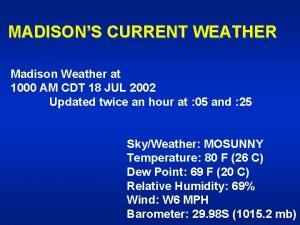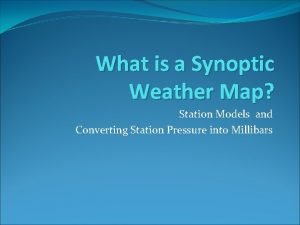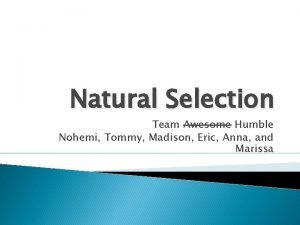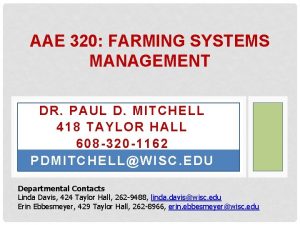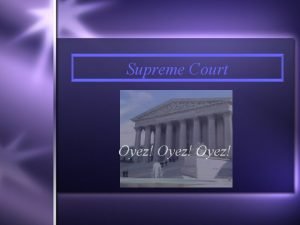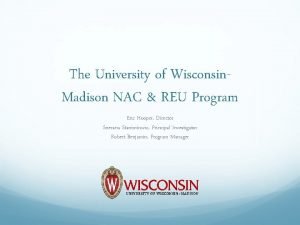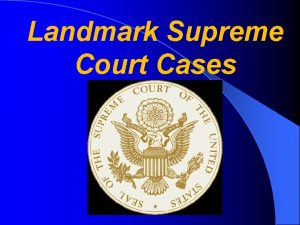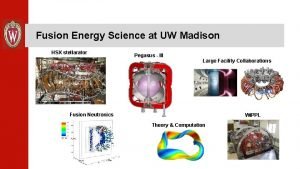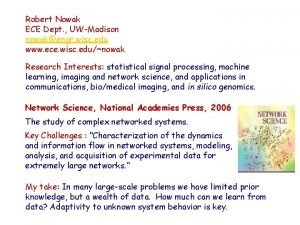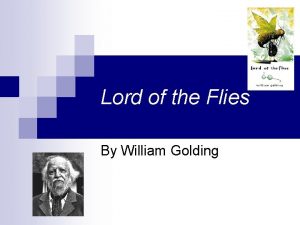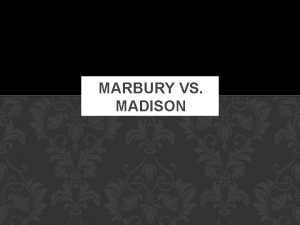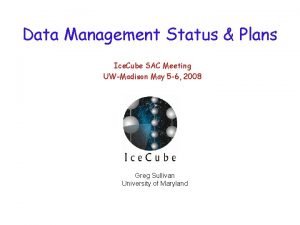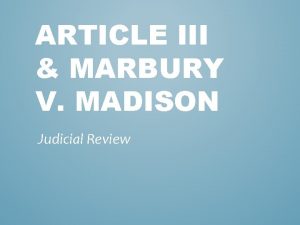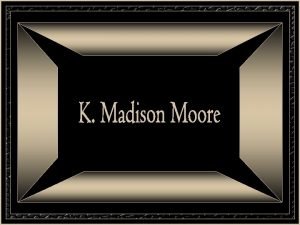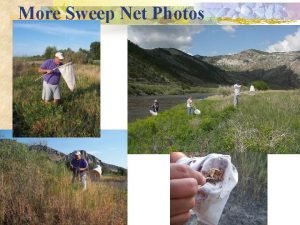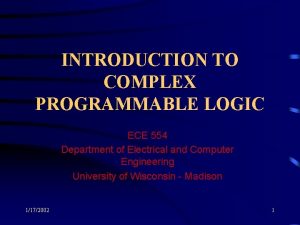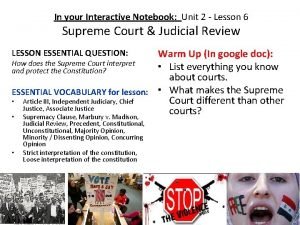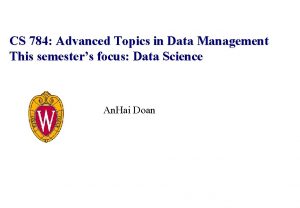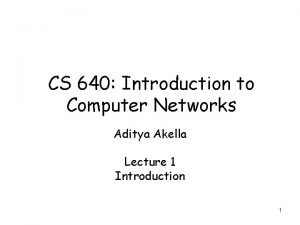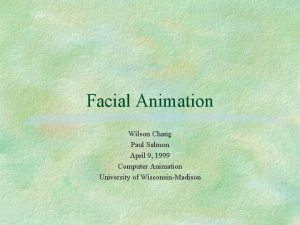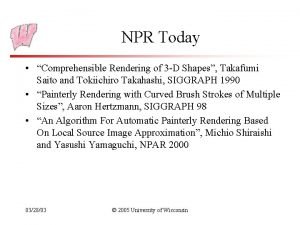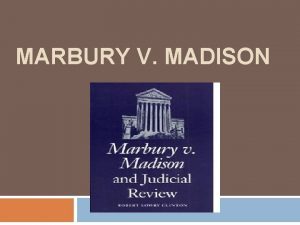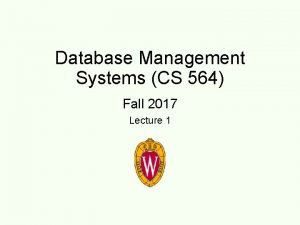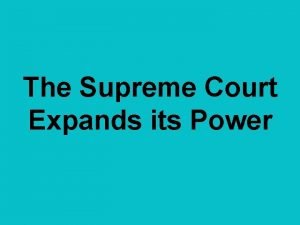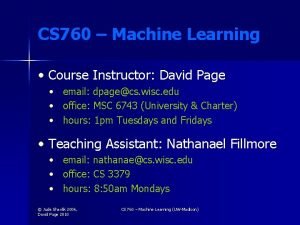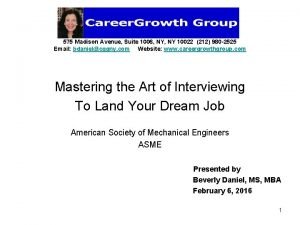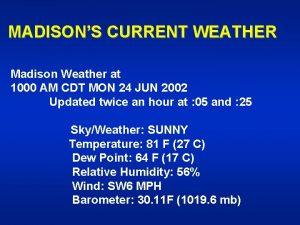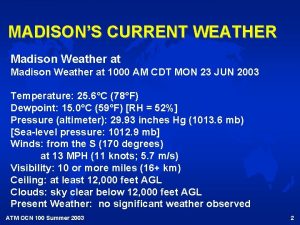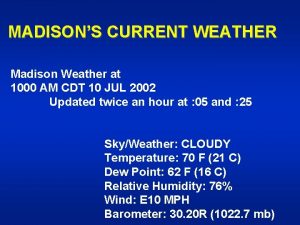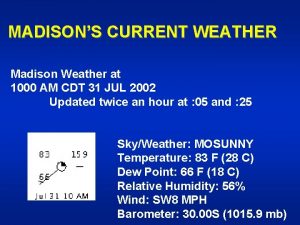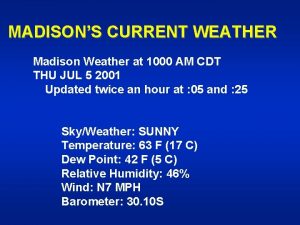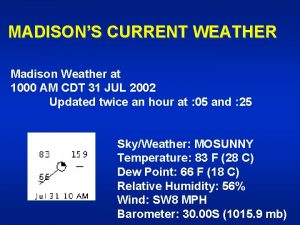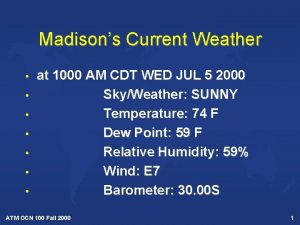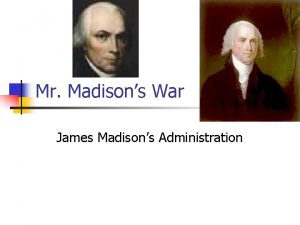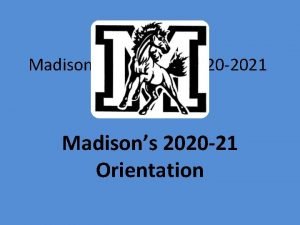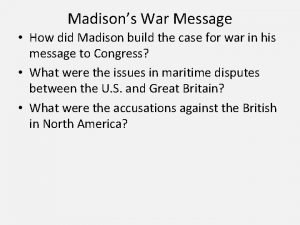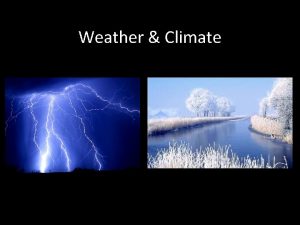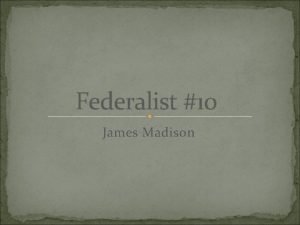MADISONS CURRENT WEATHER Madison Weather at 1000 AM































































- Slides: 63

MADISON’S CURRENT WEATHER Madison Weather at 1000 AM CDT 18 JUL 2002 Updated twice an hour at : 05 and : 25 Sky/Weather: MOSUNNY Temperature: 80 F (26 C) Dew Point: 69 F (20 C) Relative Humidity: 69% Wind: W 6 MPH Barometer: 29. 98 S (1015. 2 mb)

Last 24 hrs in Madison FOG ATM OCN 100 Summer 2002 2

Current Surface Weather Map with Isobars (“iso” = equal & “bar” = weight), Fronts and Radar ATM OCN 100 Summer 2002 6

Current Temperatures (°F) & Isotherms (“iso” = equal +”therm” = temperature) ATM OCN 100 Summer 2002 10

Current Dewpoints (o. F) ATM OCN 100 Summer 2002 11

Tomorrow AM Forecast Map ATM OCN 100 Summer 2002 15

D. BUILDING A RAINDROP (con’t. ) u u Need to add water to increase cloud droplet size to raindrop size – But… amount needed is proportional to cube of radius Factors opposing Precipitation – Cloud-producing updrafts greater than droplet’s terminal velocity; – Dry atmosphere below cloud base may evaporate droplet to form VIRGA. where. . . ATM OCN 100 Summer 2002 16

D. BUILDING A RAINDROP (con’t. ) u Terminal velocity – Dependent upon size u Amount of water needed depends upon: – Volume of spherical droplet; – or equivalently, the cube of the radius (Since V = 4/3 r 3, where r = radius). ATM OCN 100 Summer 2002 17

D. BUILDING A RAINDROP (con’t. ) u So if rcloud = 20 m, an increase to rrain = 200 m: – then a tenfold increase in radius (200 m Vs. 20 m) causes a Volume increase that would be 103 = 1000 times larger. ATM OCN 100 Summer 2002 18

D. BUILDING A RAINDROP (con’t. ) u Factors opposing Precipitation – Cloud-producing updrafts greater than droplet’s terminal velocity; – Dry atmosphere below cloud base may evaporate droplet to form VIRGA. ATM OCN 100 Summer 2002 19

Virga ATM OCN 100 Summer 2002 20

A Convective Rainshower ATM OCN 100 Summer 2002 21

E. POSSIBLE PRECIPITATION MECHANISMS (Growth of Liquid rain drops) u The current proposed mechanisms: – Simple Condensation by Diffusion Process – The Collision - Coalescence Process – The Ice Crystal or Bergeron-Findeisen Process or specifically, . . . ATM OCN 100 Summer 2002 22

PRECIPITATION MECHANISM: CONDENSATION-DIFFUSION PROCESS u u u Based upon H 20 vapor molecules condensing upon cloud droplets; Competing Effects – Curvature Effect – Solute Effect Condensation needs to overcome surface tension of droplet; Process would take 24 to 48 hours; Hence, process is too slow! ATM OCN 100 Summer 2002 23

PRECIPITATION MECHANISM: COLLISION-COALESCENCE PROCESS u u Requires droplets of various sizes, with some greater than 20 m diameter; Large droplets have greater fall speed; Figure 8. 2 Moran & Morgan (1997) ATM OCN 100 Summer 2002 24

COLLISION-COALESCENCE THEORY (con’t. ) u u u Different sized droplets have different surface electrostatic charges; Large droplet has a wake “low”; Thus, large droplets collect smaller droplets and form a rain drop. ATM OCN 100 Summer 2002 25

PRECIPITATION MECHANISM: ICE CRYSTAL (or Bergeron-Findeisen) PROCESS u Requires a mixture of ice crystals and supercooled liquid droplets; – supercooled droplet remains a liquid at -40 o. C (-40 o. F) < T < 0 o. C (32 o. F); – smaller droplets are more frequently supercooled. ATM OCN 100 Summer 2002 26

Saturation Vapor Pressure as a Function of Temperature See Fig. 6. 3 Moran & Morgan, 1997 ATM OCN 100 Summer 2002 27

ATM OCN 100 Summer 2002 28

ICE CRYSTAL THEORY (con’t. ) u Saturation vapor pressure over supercooled liquid >> over ice at same T; u Therefore, ice crystal grows at expense of supercooled water droplet. Figure 8. 3 Moran & Morgan (1997) ATM OCN 100 Summer 2002 29

F. PRECIPITATION TYPES u Distinguishing Features of Precipitation Types – Liquid (Rain, Drizzle) – Frozen (Snow, Ice Pellets, Hail) – Freezing (Freezing Rain, Freezing Drizzle) where -- ATM OCN 100 Summer 2002 30

LIQUID PRECIPITATION National Weather Service ATM OCN 100 Summer 2002 31

FROZEN PRECIPITATION National Weather Service ATM OCN 100 Summer 2002 32

Snow ATM OCN 100 Summer 2002 33

Recall PHYSICAL PHASES of H 2 O u Solid (Ice) -- Note Hexagonal (6 sided) Structure ATM OCN 100 Summer 2002 34

Varieties of Snowflakes ATM OCN 100 Summer 2002 35

Varieties of Snowflakes See Fig. 8. 6, Moran & Morgan, 1997 ATM OCN 100 Summer 2002 37

FREEZING PRECIPITATION National Weather Service ATM OCN 100 Summer 2002 38

Freezing Rain ATM OCN 100 Summer 2002 39

Freezing Rain/Ice Storm ATM OCN 100 Summer 2002 40

Hail Stones ATM OCN 100 Summer 2002 41

Hail Stones ATM OCN 100 Summer 2002 42

Hail Storm ATM OCN 100 Summer 2002 43

Snow Event ATM OCN 100 Summer 2002 44

Rain Event ATM OCN 100 Summer 2002 45

Freezing Rain Event ATM OCN 100 Summer 2002 46

Ice Pellet (Sleet) Formation ATM OCN 100 Summer 2002 47

Summary of Precipitation Type Formation ATM OCN 100 Summer 2002 48

Freezing Rain Climatology ATM OCN 100 Summer 2002 49

G. PRECIPITATION CLIMATOLOGY Annual ATM OCN 100 Summer 2002 50

H. WEATHER MODIFICATION BACKGROUND u Statement of Problem – Why no precipitation? – Can humans cause rain? u For precipitation, need: – sufficient atmospheric humidity; – a cloud; – sufficiently large raindrops/snowflakes to fall & reach ground as rain or snow. ATM OCN 100 Summer 2002 53

INTENTIONAL ARTIFICIAL WEATHER MODIFICATION u Goals – Stimulate Precipitation – Dissipate Clouds & Fog – Suppress Hail – Modify Hurricanes ATM OCN 100 Summer 2002 54

C. WEATHER MODIFICATION (con’t. ) u Precipitation Stimulation Techniques "Cloud seeding" – Early Weather Modification Techniques – Modern Precipitation Stimulation Strategies – Problems F F Scientific Legal ATM OCN 100 Summer 2002 55

TYPICAL STRATEGIES u WARM CLOUDS – Add large hygroscopic nuclei. u COLD CLOUDS – Freeze all supercooled droplets with Dry Ice (Solid CO 2); – Add freezing nuclei with ice-like crystal structure with Silver Iodide (Ag. I). ATM OCN 100 Summer 2002 56

ATM OCN 100 - Summer 2002 LECTURE 16 ATMOSPHERIC OPTICAL PHENOMENA A. INTRODUCTION – Definition & Scope – Historical Background ATM OCN 100 Summer 2002 57

B. NATURE OF VISIBLE LIGHT u The Electromagnetic Spectrum – A review ATM OCN 100 Summer 2002 58

B. NATURE OF VISIBLE LIGHT (con’t. ) u Visible Light, Sunlight & the Electromagnetic Spectrum – I. Newton, sunlight & polychromatic light u Visible Light, Color & Human Visual Perception ATM OCN 100 Summer 2002 59

C. OPTICAL PROCESSES Optical Phenomena depends upon Processes affecting sunlight u Review of Optical Processes u – Scattering – Reflection – Refraction – Dispersion – Diffraction where. . . ATM OCN 100 Summer 2002 60

SCATTERING u u u Redirection of light ray due to suspended particles. New direction may be in forward or backward direction. Depends upon relative size of scatterer: – Rayleigh Scatter [small particles] – Mie Scatter [large particles] ATM OCN 100 Summer 2002 61

ATM OCN 100 Summer 2002 62

REFLECTION u u Redirection of light ray in backward direction by large surface. Depends upon reflecting surface: – Specular – Diffuse ATM OCN 100 Summer 2002 63

Reflection Relationship Angle of reflection = angle of incidence ATM OCN 100 Summer 2002 64

Specular and Diffuse Reflection ATM OCN 100 Summer 2002 65

Comparisons ATM OCN 100 Summer 2002 66

REFRACTION u Redirection of light ray within medium due to density differences. ATM OCN 100 Summer 2002 67

REFRACTION (con’t. ) u Depends upon: – density of medium – wavelength of light – incident angle u Relationship (Snell’s Law) Angle of refraction angle of incidence ATM OCN 100 Summer 2002 68

Refraction (con’t. ) ATM OCN 100 Summer 2002 69

Refraction (con’t. ) ATM OCN 100 Summer 2002 70

DISPERSION u Separation of polychromatic light ray into component colors during passage through a medium. ATM OCN 100 Summer 2002 71

DISPERSION (con’t. ) u u Requires concurrent refraction. Depends upon: – density of medium – wavelength of light ATM OCN 100 Summer 2002 72

Dispersion ATM OCN 100 Summer 2002 73

DIFFRACTION u Constructive & destructive interference patterns of light waves due to slight bending of light ray moving around an object. ATM OCN 100 Summer 2002 74

DIFFRACTION (con’t. ) u u Requires small openings or objects. Produces light and dark bands. Depends upon wavelength. Polychromatic light ray may be broken into component colors. ATM OCN 100 Summer 2002 75
 Madison current weather
Madison current weather Balanced wye-wye connection
Balanced wye-wye connection Y connected generator
Y connected generator Hazard based safety engineering
Hazard based safety engineering Drift current
Drift current Slideplayer
Slideplayer Difference between phase voltage and line voltage
Difference between phase voltage and line voltage Mesh current method with current source
Mesh current method with current source Drift current and diffusion current
Drift current and diffusion current Diffusion current formula
Diffusion current formula Energy band diagram of pn junction diode
Energy band diagram of pn junction diode The jfet always operates with
The jfet always operates with Which electrode is positive
Which electrode is positive Ac theory 3 lesson 4
Ac theory 3 lesson 4 How to read a weather station model
How to read a weather station model Heavy weather by weather report
Heavy weather by weather report We'll weather the weather poem
We'll weather the weather poem Capital weather gang weather wall
Capital weather gang weather wall Its windy gif
Its windy gif Weather station model
Weather station model Whether the weather is fine
Whether the weather is fine Whether the weather is fine tongue twister
Whether the weather is fine tongue twister Tommy madison
Tommy madison Aae 320
Aae 320 Oyez marbury v madison
Oyez marbury v madison Uw madison reu
Uw madison reu James madison rotc
James madison rotc Obiee uw madison
Obiee uw madison V
V Madison wire
Madison wire Caitlin meehan
Caitlin meehan Fort madison community school district
Fort madison community school district Hsx uw madison
Hsx uw madison Robert nowak uw madison
Robert nowak uw madison Jack the
Jack the Marbury vs madison comic strip
Marbury vs madison comic strip Michelle holland uw madison
Michelle holland uw madison Student health insurance plan uw madison
Student health insurance plan uw madison Sac uw madison
Sac uw madison Sona systems uw madison
Sona systems uw madison Zjhz
Zjhz Marbury v madison background
Marbury v madison background Madison college dental clinic
Madison college dental clinic Madison moore nude
Madison moore nude Msa swim madison al
Msa swim madison al History of line dance
History of line dance Peta save the whales
Peta save the whales Madison bug sweep
Madison bug sweep Ece 554 uw madison
Ece 554 uw madison Uw madison neuroscience
Uw madison neuroscience Judicial branch digital notebook answer key
Judicial branch digital notebook answer key Cs 784
Cs 784 Aditya akella
Aditya akella Paul salmon madison
Paul salmon madison What does james madison argue in federalist 10
What does james madison argue in federalist 10 Cs 559 uw madison
Cs 559 uw madison James madison if men were angels
James madison if men were angels Marbury v madison judicial review
Marbury v madison judicial review Cs 564 uw madison github
Cs 564 uw madison github V
V Cs 368 uw madison
Cs 368 uw madison 575 madison avenue
575 madison avenue Spss uw madison
Spss uw madison Madison smiley
Madison smiley
